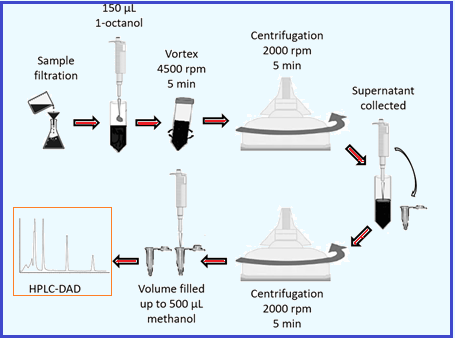A fast, low-cost and eco-friendly method for routine determination of Bisphenol-A in landfill leachate employing vortex assisted liquid-liquid extraction
Volume 4, Issue 03, Pages 59-67, Sep 2021 *** Field: Environmental Analytical Chemistry
Abstract
Landfills are sites designed to receive and final disposal of a broad variety of urban solid wastes (USW). The decomposition and biodegradation processes generate a leachate of high complexity and toxicity, containing persistent and recalcitrant contaminants that are not usually monitored. Bisphenol-A (BPA) is a synthetic compound applied mostly on the production of polycarbonate plastics, epoxy resins, and is an endocrine disruptor. The presence of BPA in USW urges the development of feasible analytical methods to support the effluent treatment plants and reduce the risks of contamination. The main goal of this work was to develop an efficient, eco-friendly, fast and simple method for routine analysis of BPA in the leachate from landfill. A vortex assisted liquid-liquid extraction (VALLME) using 1-octanol as solvent was performed. BPA recoveries at spiking levels of 2.5, 6.5 and 12.5 µg L-1 were between 60 to 104% with relative standard deviation (RSD) lower than 26%. The linearity of the method was evaluated and the correlation coefficient was (r) 0.9985. The limit of quantification (LOQ) was 2.5 µg L-1 with a pre-concentration factor of 20. The method has advantages such as low consumption of extraction solvent (150 µL), low cost, easy and fast determination.
References
Y. Ma, H. Liu, J. Wu, L. Yuan, Y. Wang, X. Du, R. Wang, P.W. Marwa, P. Petlulu, X. Chen, H. Zhang, The adverse health effects of bisphenol A and related toxicity mechanisms, Environ. Res., 176 (2019) 108575.
R. B. Gear, S. M. Belcher, Impacts of Bisphenol A and ethinyl estradiol on male and female CD-1 mouse spleen, Sci. Rep., 7 (2017) 856.
S. M. Zimmers, E. P. Browne, P. W. O’Keefe, D. L. Anderton, L. Kramer, D. A Reckhow, K. F. Arcaro, Determination of free Bisphenol A (BPA) concentrations in breast milk of U.S. women using a sensitive LC/MS/MS method, Chemospher, 104 (2014), 237-243.
Y-K. Leung, V. Govindarajah, A. Cheong, J. Veevers, D. Song, R. Gear, X. Zhu, J. Ying, A. Kendler, M. Medvedovic, S. Belcher, S-M. Ho, Gestational high-fat diet & bisphenol A exposure heightens mammary cancer risk, Endocr. Relat. Cancer, 24 (2017) 365-378.
N. Dorival-García, A. Zafra-Gómez, A. Navalón, J.L. Vílchez, Improved sample treatment for the determination of bisphenol A and its chlorinated derivatives in sewage sludge samples by pressurized liquid extraction and liquid chromatography-tandem mass spectrometry, Talanta, 101 (2012) 01-10.
S. Almeida, A. Raposo, M. Almeida-González, C. Carrascosa, Bisphenol A: Food Exposure and Impact on Human Health, Compr. Rev. Food Sci. Food Saf., 17 (2018) 1503-1517.
X. Hu, X. Wu, F. Yang, Q. Wang, C. He, S. Liu, Novel surface dummy molecularly imprinted silica as sorbent for solid-phase extraction of bisphenol A from water samples, Talanta, 148 (2016) 29-36.
A. C. Narevski, M. I. Novaković, M. Z. Petrović, I. J. Mihajlović, N. B. Maoduš, G.V. Vujić, Occurrence of bisphenol A and microplastics in landfill leachate: lessons from South East Europe, Environ. Sci. Pollut. Res., 28 (2021) 42196–42203 (2021).
H. Wang, H. Yan, C. Wang, F. Chen, M. Ma, W. Wang, X. J. Wang, Analysis of phenolic pollutants in human samples by high performance capillary electrophoresis based on pretreatment of ultrasound-assisted emulsification microextraction and solidification of floating organic droplet, Chromatogr. A, 1253 (2012) 16-21.
Y. Vicente-Martinez, M. Caravaca, A. Soto-Meca, Determination of very low concentration of bisphenol A in toys and baby pacifiers using dispersive liquid-liquid microextraction by In situ ionic liquid formation and high-performance liquid chromatography, Pharmaceuticals, 13 (2020) 301.
P-P, Hao, Determination of bisphenol A in barreled drinking water by a SPE–LC–MS method, J. Environ. Sci. Health A Tox. Hazard. Subst. Environ. Eng., 55 (2020) 697-703.
M. Caban, O. Stepnowaski, The Quantification of bisphenols and their analogues in wastewaters and surface water by an improved solid-phase extraction gas chromatography/mass spectrometry method, Environ. Sci. Pollut. Res., 27 (2020) 28829-28839.
S. Cho, Y. S. Choi, H. M. D. Luu, J. Guo, Determination of total leachable bisphenol A from polysulfone membranes based on multiple consecutive extractions, Talanta, 101 (2012) 537-540.
M. Sadeghi, Z. Nematifar, N. Fattahi, M. Pirsaheb, M. Shamsipur, Determination of bisphenol A in food and environmental samples using combined solid-phase extraction-dispersive liquid-liquid microextraction with solidification of floating organic drop followed by HPLC, Food Anal. Methods, 9 (2016) 1814-1824.
R. Amini, J. Khandaghi, M. R. A. Mogaddam, Combination of vortex-assisted liquid–liquid extraction and air-assisted liquid–liquid microextraction for the extraction of bisphenol A and bisphenol B in canned doogh samples, Food Anal. Methods, 11 (2018) 3267-3275.
C. Bosch Ojeda, F. Sánchez Rojas, Vortex-assisted liquid–liquid microextraction (VALLME): applications, Chromatographia, 77 (2014) 745-754.
A. Laganà, A. Bacaloni, I. De Leva, A. Faberi, G. Fago, A. Marino, Analytical methodologies for determining the occurrence of endocrine disrupting chemicals in sewage treatment plants and natural waters, Anal. Chim. Acta, 501 (2004) 79-88.
A. Cariot, A. Dupuis, M. Albouy-Llaty, B. Legube, S. Rabouan, V. Migeot, Reliable quantification of bisphenol A and its chlorinated derivatives in human breast milk using UPLC-MS/MS method, Talanta, 100 (2012) 175-182.
L. Correia-Sá, S. Norberto, C. Delerue-Matos, C. Calhau, V. F. J. Domingues, Micro-QuEChERS extraction coupled to GC-MS for a fast determination of Bisphenol A in human urine, Chromatogr. B, 1072 (2017) 9-16.
J. López-Darias, V. Pino, J. H. Ayala, A. M. Afonso, ‘In-situ ionic liquid-dispersive liquid-liquid microextraction method to determine endocrine disrupting phenols in seawaters and industrial effluents, Microchim. Acta, 174 (2011) 213-222.
X. Sun, J. Peng, M. Wang, C. Tang, L.Yang, H. Lei, F. Li, X. Wang, J. J. Chen, Determination of nine bisphenols in sewage and sludge using dummy molecularly imprinted solid-phase extraction coupled with liquid chromatography tandem mass spectrometry, Chromatogr. A, 1552 (2018) 10-16.
K. Owczarek, P. Kubica, B. Kudlak, A. Rutkowska, A. Konieczna, D. Rachoń, J. Namieśnik, A. Wasik, Determination of trace levels of bisphenol A analogues in human blood sérum by high performance liquid chromatography-tandem mass spectrometry, Sci. Total Environ., 628-629 (2018) 1362-1368.
Z. Wang, J. Yu, L.Wu, H. Xiao, J. Wang, R. J. Gao, Simultaneous identification and quantification of bisphenol A and 12 bisphenol analogues in environmental samples using precolumn derivatization and ultra high performance liquid chromatography with tandem mass spectrometry, Separation Sci., 41 (2018) 2269-2278.
N. Fabregat-Cabello, J. Pitarch-Motellón, J. V. Sancho, M. Ibáñez, A. F. Roig-Navarro, Method development and validation for the determination of selected endocrine disrupting compounds by liquid chromatography mass spectrometry and isotope pattern deconvolution in water samples: comparison of two extraction techniques, Anal. Methods, 8 (2016) 2895-2903.
O. Ros, A. Vallejo, L. Blanco-Zubiaguirre, M. Olivares, A. Delgado, N. Etxebarria, A. Prieto, Microextraction with polyethersulfone for bisphenol-A alkyphenols and hormones determination in water samples by means of gas chromatography-mass spectrophotometry and liquid chromatography-tandem mass spectrometry analysis, Talanta, 134 (2015) 247-255.

JOURNAL PUBLISHING AGREEMENT
PLEASE PROVIDE US THE FOLLOWING INFORMATION,
Article entitled:
Corresponding author:
To be published in the journal:
Your Status
I am the sole author of the manuscript
- I am an Iranian government employee.
- I am a European government employee
- I am a Asian government
- None of the above
I am one author signing on behalf of all co-authors of the manuscript
- I am an Iranian government employee.
- I am a European government employee
- I am a Asian government
- None of the above
Please tick the above blanks (as appropriate), review the Journal Publishing Agreement, and then sign and date the document in black ink.
Published Journal Article: the author may share a link to the formal publication through the relevant DOI. Additionally theses and dissertations which contain embedded Published Journal Articles as part of the formal submission may be hosted publicly by the awarding institution with a link to the formal publication through the relevant DOI. Any other sharing of Published Journal Articles is by agreement with the publisher only.
Signed: ______________________________________ Name printed: ___________________________________________
Title and Company (if employer representative): _______________________Date: __________________________________














